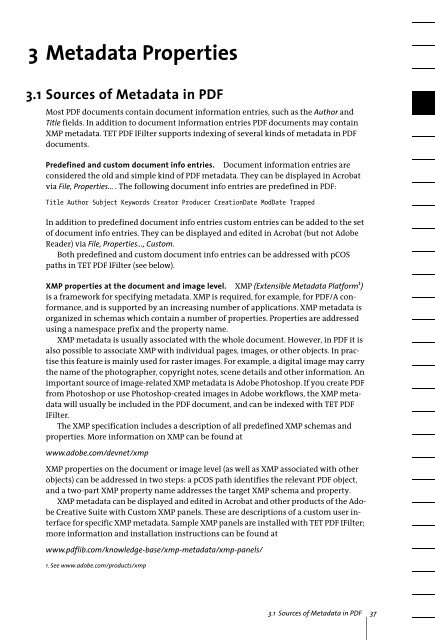PDFlib TET PDF IFilter 4.0 Manual
PDFlib TET PDF IFilter 4.0 Manual
PDFlib TET PDF IFilter 4.0 Manual
Create successful ePaper yourself
Turn your PDF publications into a flip-book with our unique Google optimized e-Paper software.
3 Metadata Properties<br />
3.1 Sources of Metadata in <strong>PDF</strong><br />
Most <strong>PDF</strong> documents contain document information entries, such as the Author and<br />
Title fields. In addition to document information entries <strong>PDF</strong> documents may contain<br />
XMP metadata. <strong>TET</strong> <strong>PDF</strong> <strong>IFilter</strong> supports indexing of several kinds of metadata in <strong>PDF</strong><br />
documents.<br />
Predefined and custom document info entries. Document information entries are<br />
considered the old and simple kind of <strong>PDF</strong> metadata. They can be displayed in Acrobat<br />
via File, Properties... . The following document info entries are predefined in <strong>PDF</strong>:<br />
Title Author Subject Keywords Creator Producer CreationDate ModDate Trapped<br />
In addition to predefined document info entries custom entries can be added to the set<br />
of document info entries. They can be displayed and edited in Acrobat (but not Adobe<br />
Reader) via File, Properties..., Custom.<br />
Both predefined and custom document info entries can be addressed with pCOS<br />
paths in <strong>TET</strong> <strong>PDF</strong> <strong>IFilter</strong> (see below).<br />
XMP properties at the document and image level. XMP (Extensible Metadata Platform 1 )<br />
is a framework for specifying metadata. XMP is required, for example, for <strong>PDF</strong>/A conformance,<br />
and is supported by an increasing number of applications. XMP metadata is<br />
organized in schemas which contain a number of properties. Properties are addressed<br />
using a namespace prefix and the property name.<br />
XMP metadata is usually associated with the whole document. However, in <strong>PDF</strong> it is<br />
also possible to associate XMP with individual pages, images, or other objects. In practise<br />
this feature is mainly used for raster images. For example, a digital image may carry<br />
the name of the photographer, copyright notes, scene details and other information. An<br />
important source of image-related XMP metadata is Adobe Photoshop. If you create <strong>PDF</strong><br />
from Photoshop or use Photoshop-created images in Adobe workflows, the XMP metadata<br />
will usually be included in the <strong>PDF</strong> document, and can be indexed with <strong>TET</strong> <strong>PDF</strong><br />
<strong>IFilter</strong>.<br />
The XMP specification includes a description of all predefined XMP schemas and<br />
properties. More information on XMP can be found at<br />
www.adobe.com/devnet/xmp<br />
XMP properties on the document or image level (as well as XMP associated with other<br />
objects) can be addressed in two steps: a pCOS path identifies the relevant <strong>PDF</strong> object,<br />
and a two-part XMP property name addresses the target XMP schema and property.<br />
XMP metadata can be displayed and edited in Acrobat and other products of the Adobe<br />
Creative Suite with Custom XMP panels. These are descriptions of a custom user interface<br />
for specific XMP metadata. Sample XMP panels are installed with <strong>TET</strong> <strong>PDF</strong> <strong>IFilter</strong>;<br />
more information and installation instructions can be found at<br />
www.pdflib.com/knowledge-base/xmp-metadata/xmp-panels/<br />
1. See www.adobe.com/products/xmp<br />
3.1 Sources of Metadata in <strong>PDF</strong> 37
















